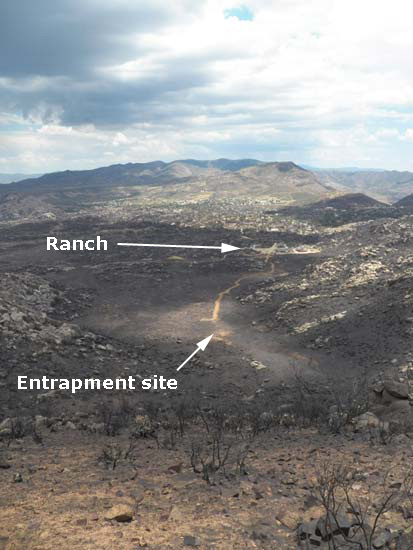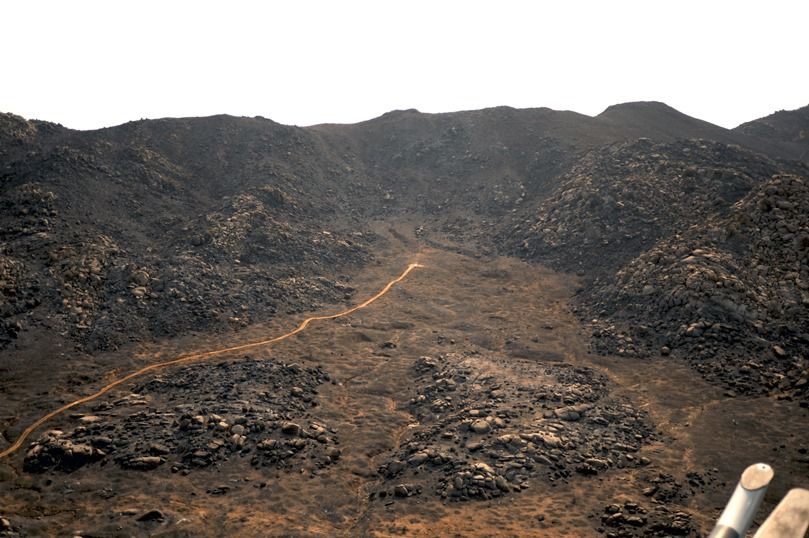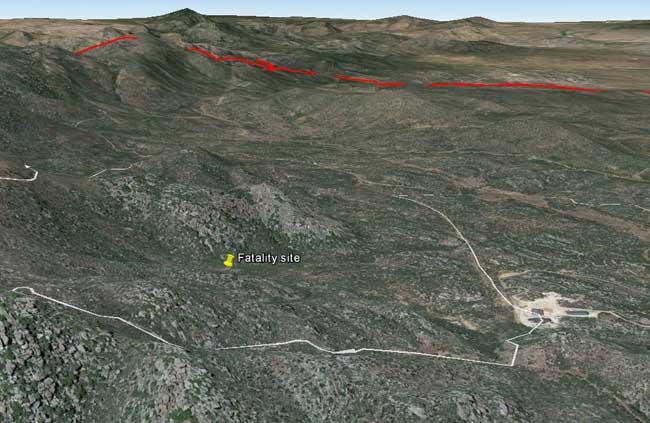
Prescott Fire Department Division Chief Darrell Willis on Tuesday escorted members of the media to the site on the Yarnell Hill fire where 19 members of the Granite Mountain Hotshots were killed June 30. John Dougherty, an investigative reporter who has written for the New York Times, was there and recorded these videos of Chief Willis’ briefing. They are embedded here with his permission. John also wrote an article about his visit to the site.
The first video is the Chief providing his understanding of what happened, and in the second he takes questions from the reporters.
In the photo below of the entrapment site, which is looking toward the west, the road was punched in by a dozer after the incident to facilitate the removal of the bodies, which were at the end of the road. The photo was taken by Wade Ward of the Prescott FD, and is used here with permission.

This is the first time I have heard that the Hotshots lit an escape fire. Chief Willis said the tactic is very common. Escape fires, an emergency procedure to save firefighter’s lives by removing fuel before the main fire approaches, are actually extremely rare. The Chief may have been referring to backfiring, or burning out, which are much more common.
The most famous use of an escape fire was on the 1949 Mann Gulch fire when Wag Dodge, the crew boss, lit one. He then got into the new black and survived, but the rest of the crew did not understand what he was doing, (lighting more fire? WTF?) and 13 of them were killed.
Another point that the Chief brought up is something I have seen mentioned once or twice elsewhere — the fire approached the fatality site from the east, blown by the wind into the mouth of the U-shaped or box canyon. This may have been a surprise for the Hotshots, who could have thought the fire was north of them on the other side of the ridge. The thunderstorm with its outflowing winds would have caused the wind direction to change as it moved from the northeast to the southwest, possibly switching from coming out of the north-northeast or northeast, to the east.
The 3-D map below is another view of the entrapment site, this time looking toward the north. The ranch, at the lower-right, is 1,900 feet from the site.



Escape Fire, not used very often. Works in grass fuels ONLY! Steeper the slope the better the results. Allows you to move into the “black” quicker. Don’t even think about attempting this is brush fuel types.
Even though I imagine the pain he is feeling, the deputy chiefs version of the events are just that. The only people who really know what happened (19 hotshots) are no longer around to tell the truth, as compared to theories or versions…
With all due respect for Chief Willis, I must disagree that it is ingrained in firefighters to save structures. That is no doubt true of structural firefighters who go to work with engines, lots of water, bunker gear and SCBAs. But wildland firefighters have a different mission, i.e. to contain a small fire and prevent it from turning into a very large fire. The Granite Mountain Hotshots, as members of the Prescott FD, probably had been trained in structural firefighting, but were not equipped to do it that day. I’ve heard wildland fire officials state publicly for many years that no wildland firefighters will be put at risk to save structures. As a former hotshot, I never felt that it was my duty to save structures. The lives of the firefighters are always more important. That is true whether you are doing wildland or structural firefighting.
Firefighter Hayes has accurately stated a paradox that exists in the political vs tactical world of wildland firefighting: Federal firefighters protect federal lands; Local Government and State firefighters protect private lands. The statements by Chief Willis definitely apply outside federal jurisdictions. No Chief, no fireline supervisor, no crew or engine supervisor is going to expose their crew to unnecessary risk based on current conditions and experience of the supervisor. But if you live on or near federal lands do not expect your property to survive undamaged. If you live in private lands under local or state protection you can depend on the firefighters to make their best effort to protect your life and property. There are many documented incidents of wildland firefighters being entrapped while moving through the “green” during active fire behavior periods. All wildland firefighters should review and learn from these tragedies: Mann Gulch, Rattlesnake, Loop, Thirty Mile, etc, etc.
My heart breaks for Chief Willis…he’s in a tough spot. He handled himself very well in these videos. And I’m very pleased to hear from ‘Michele Steinberg’ that Chief Willis is so devoted to helping communities become Firewise. Everyone must fully understand what we are facing. This is especially true for land/home owners in the Wildland-Urban Interface. Our expectations must be based on reality and not merely hope. Lives depend on this.
Thank you for posting these interviews, Bill, and for some of your clarifying comments and reflections. Chief Willis is an incredible leader and has been instrumental in working with local communities to become Firewise over many years.